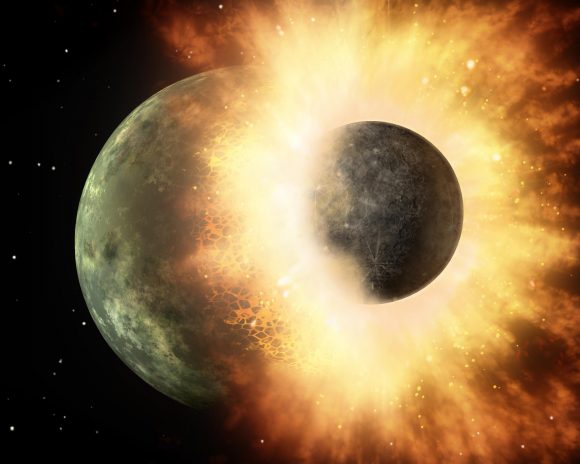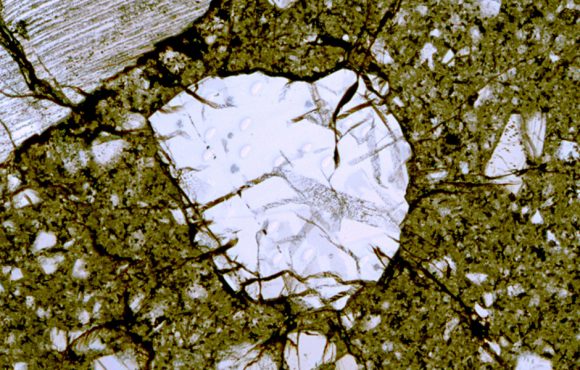For decades, scientists have been of the belief that the Moon, Earth’s only natural satellite, was four and a half billion years old. According to this theory, the Moon was created from a fiery cataclysm produced by a collision between the Earth with a Mars-sized object (named Theia) roughly 100 million years after the formation of primordial Earth.
But according to a new study by researchers from UCLA (who re-examined some of the Apollo Moon Rocks), these estimates may have been off by about 40 to 140 million years. Far from simply adjusting our notions of the Moon’s proper age, these findings are also critical to our understanding of the Solar System and the formation and evolution of its rocky planets.
This study, titled “Early formation of the Moon 4.51 billion years ago“, was published recently in the journal Science Advances. Led by Melanie Barboni – a professor from the Department of Earth, Planetary, and Space Sciences at UCLA – the research team conducted uranium-lead dating on fragments of the Moon rocks that were brought back by the Apollo 14 astronauts.

These fragments were of a compound known as zircon, a type of silicate mineral that contains trace amounts of radioactive elements (like uranium, thorium, and lutetium). As Kevin McKeegan, a UCLA professor of geochemistry and cosmochemistry and a co-author of the study, explained, “Zircons are nature’s best clocks. They are the best mineral in preserving geological history and revealing where they originated.”
By examining the radioactive decay of these elements, and correcting for cosmic ray exposure, the research team was able to get highly precise estimates of the zircon fragments ages. Using one of UCLA’s mass spectrometers, they were able to measure the rate at which the deposits of uranium in the zircon turned into lead, and the deposits of lutetium turned into hafnium.
In the end, their data indicated that the Moon formed about 4.51 billion years ago, which places its birth within the first 60 million years of the Solar System or so. Previously, dating Moon rocks proved difficult, mainly because most of them contained fragments of many different kinds of rocks, and these samples were determined to be tainted by the effects of multiple impacts.
However, Barboni and her team were able to examine eight zircons that were in good condition. More importantly, these silicate deposits are believed to have formed shortly after the collision between Earth and Theia, when the Moon was still an unsolidified mass covered in oceans of magma. As these oceans gradually cooled, the Moon’s body became differentiated between its crust, mantle and core.

Because zircon minerals were formed during the initial magma ocean, uranium-lead dating reaches all the way back to a time before the Moon became a solidified mass. As Edward Young, a UCLA professor of geochemistry and cosmochemistry and a co-author of the study, put it, “Mélanie was very clever in figuring out the Moon’s real age dates back to its pre-history before it solidified, not to its solidification.”
These findings have not only determined the age of the Moon with a high degree of accuracy (and for the first time), it also has implications for our understanding of when and how rocky planes formed within the Solar System. By placing accurate dates on when certain bodies formed, we are able to understand the context in which they formed, which also helps to determine what mechanisms were involved.
And this was just the first revelation produced by the research team, which hopes to continue studying the zircon fragments to see what they can learn about the Moon’s early history.
Further Reading: UCLA


Really interesting. For decades, some Russian researchers have concluded- based not only on a variety of evidence from the Apollo missions, but also from the writings of early civilizations- that the Moon is actually OLDER than the Earth, and came from elsewhere.
This idea to date has mostly be scoffed at and ridiculed by the mainstream Astronomy community. While I understand that these researchers are not saying that either, it certainly gets us much closer in that direction.
Nice article, Matt!
Thanks Jim!
More realistically, by pinpointing a date they have better closed off any likelihood of such an idea. Because that is all what it is if it is founded in myth – which is the writings of early civilizations, aside from clerical data on grain storage and such.
Is that a reference to russian born Velikovsky? We don’t know, since you don’t give references. Velikovsky was not a scientist, he wasn’t even a researcher in astronomy, he was a scholar of biblical [hi]story [ https://en.wikipedia.org/wiki/Immanuel_Velikovsky ].
Jim:
Nothing in the article states that the moon came from some where else. The forming was still by “More importantly, these silicate deposits are believed to have formed shortly after the collision between Earth and Theia,”
And Matt, why would you give support to “that the Moon is actually OLDER than the Earth, and came from elsewhere.”
Or is that what you also believe, even though the all evidence, even this article, points to a collision with Earth and Theia.
OK, I’m done. Ken
I never stated anything to that effect, Ken. I thanked him for complimented the article. How you could have concluded that I agreed with his belief from that alone is beyond me.
Ken,
Ease your piece. Matt was just being courteous to my response, and in no way did I even take his acknowledgement as agreement.
I just found it interesting that something Russian scholars argued decades ago- which was routinely scoffed at by mainstream academics- now looks to be true: the age of the Moon was far older than we thought.
And while it’s not addressed, I can’t help but find the authors’ age of the Moon (4.51 BYA) as curious, given that the Earth is generally assumed to have formed around 4.5 BYA. Is this just a coincidence, or intentional?
the beauty of science – when we think we KNEW something was FACT is indeed not
It was never know, as you state, FACT. It has always been a hypothesis, waiting for more information to come forth.
Every science expert knows that the moon is in fact a interstellar spaceship that originally brought our ancestors here. No doubt we humans or some close semblance thereof, have been moving between planets trying to establish a presence at two or more locations in our solar system in order to avoid total nuclear destruction. With advances in technology comes the necessity to flee to safer places.
Well then Matt, you should have stated “I thanked him for complimented the article.” And not what he believes to be true.
As you did not, it came off as if you were supporting his statements.
Look at it from the view of some one who does not know what was in your head at the time. You have to realize that we the readers expect you to know the difference.
Ken
Well then Matt, you should have stated “I thanked him for complimented the article.” And not what he believes to be true.
As you did not, it came off as if you were supporting his statements
That is how I could and did, have concluded that you agreed with his belief
Look at it from the view of some one who does not know what was in your head at the time.
You have to realize that we the readers expect you to know the difference. Sigh!
The same as we have no knowledge of what it going through the mind of ezscott, when his/her post was made.
Ken Price
That’s quite the interesting argument, and completely baseless. You and you alone made an assumption based on a negative – i.e. something I didn’t say – so speaking on behalf of other readers seems presumptuous. Perhaps you should take better care to know the difference between simply thanking someone for a compliment and agreeing with a theory they state.
Darn double post. The first did not show so I did another.
“A collision with Earth and Theia”…
Very unlikely. More probable we would have rings like Saturn if this were in fact true. See if there is zircon in the rings of Saturn. I bet not.
Albert Einstein depended on the size and distance of the moon to be
able to prove his theory of gravity. Precise measurements of the light
and recordings… Repeated… Gave us the ever expanding knowledge of space and time. [Space-time].
So the Moon in it’s Spacetime, is the revelation of how we got here and how we can leave [escape] from here.
Except we did have rings, that’s part of the collision and moon formation hypothesis. When Theia struck the proto-Earth, all the debris was flung into orbit and eventually formed into the Moon. Until that formation, we obviously had a debris ring.
Rings are not a permanent structure, not even with Saturn. There is a reason why many of Saturn’s moons are referred to as ‘Shepherd Moons’. They maintain and even help to create or replenish the multitude of rings around the planet. The main reason why this did not happen here is because of various factors of scale and gravitational variances. The Earth, naturally, is much smaller than Saturn and overall due to this and other factors of our orbital position has a much smaller gravitational footprint/well. At the same time, the Moon that formed is significantly larger in comparison to the parent than any other moon in the solar system. This left little room for such excess debris to constitute a ring system as anything that did not get flung back down to the Earth or get pulled in to form the Moon, was ejected by the gravitational interactions of both bodies.
There are other factors that would contribute to this, but this is the basic idea.
I see this point of yours DashDragon, but do the other moon[s] of the other planets in our solar system increase their average distance from their respective planet they orbit, or do they all have decaying orbits?
As old as our solar system is- in a decaying moon system, most all planets moon[s] should have crashed into their respective planets as would their rings would “crash” into their moons. The fact that we can still another planets moon[s], suggest this is because their moon was *much further away from it’s respective planet at an earlier time.
The Moon of our Earth would have crashed in to Earth too if its orbit was one of decay. Yet we can see that our moon is still there. Actually our moon is moving away from the earth on the average distance. So the idea that it is like the rest of the solar systems moon[s] may not be so.
It would be interesting to determine how the Earth-Moon system would appear if this average distance that the moon travels away from the earth could be reversed on a time line along with the zircon time dating . Unfortunately A match doesn’t seem possible unless the moon came from elsewhere.